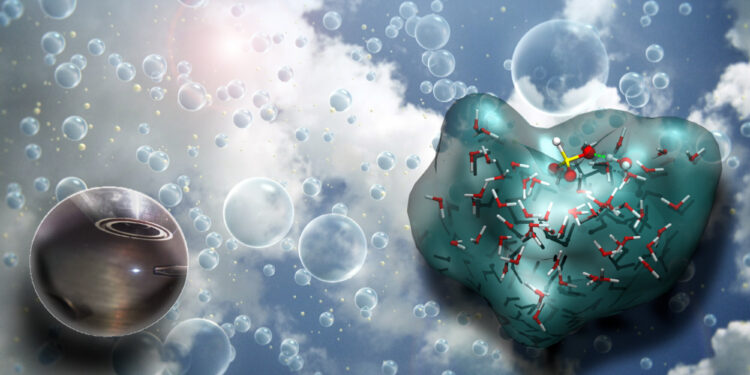Combined spectroscopy and atomistic simulations allow a better understanding of the specific molecular processes governing the formation of air pollution. Credit: FHI, NASA Goddard Space Flight Center
A team of researchers has made a discovery by understanding how air pollution forms at the molecular level. Their investigation, published in the journal Natural communicationshighlights the complex chemical processes occurring at the boundary between liquids, particularly aqueous solutions, and vapor in our atmosphere.
The international study focuses on the differences between complex acid-base equilibria (i.e. the ratio between basic and acidic components) within the mass of a solution, on the one hand, and at the very interface between the solution and the surrounding vapor, on the other hand. While it is simple to measure acid-base equilibria throughout the bulk of a solution using state-of-the-art methods, it is difficult to determine these equilibria at the boundary between a solution and the surrounding gas phase.
Even though this boundary layer is about a hundred thousand times narrower than a human hair, it plays a very important role in the processes that influence air pollution and climate change. Examining the chemistry of the solution-vapor boundary at the molecular scale thus contributes to developing improved models for our understanding of the fate of aerosols in the atmosphere and their influence on global climate.
Key findings include:
- Complex acid-base balances determined: Researchers used complementary spectroscopic methods to unravel the complex acid-base balances that result when the pollutant sulfur dioxide (SO2) is dissolved in water.
- Unique behavior at the liquid-vapor interface: under acidic conditions, the tautomeric equilibrium between bisulfite and sulfonate is strongly shifted toward the sulfonate species.
- Stabilization at the interface: Molecular dynamic simulations revealed that the sulfonate ion and its acid (sulfonic acid) are stabilized at the interface due to ion pairing and higher dehydration barriers, respectively. This explains why the tautomeric equilibria are shifted at the interface.
The results highlight the contrasting behaviors of chemicals at the interface compared to the overall environment. This difference has a significant impact on how sulfur dioxide is absorbed and reacts with other pollutants like nitrogen oxides (NOx) and hydrogen peroxide (H2Oh2) in the atmosphere. Understanding these processes is crucial for developing strategies to reduce air pollution and its harmful effects on health and the environment.
The team includes research from the Fritz Haber Institute of the Max Planck Society in Berlin, the Qatar Environment and Energy Research Institute/Hamad Bin Khalifa University, the PETRA III synchrotrons in Hamburg and SOLEIL in Gif-sur-Yvette (France) , from the Sorbonne University of Paris, ETH Zurich and PSI Center for Energy and Environmental Sciences (Switzerland)
More information:
Tillmann Buttersack et al, Direct observation of complex S(IV) equilibria at the liquid-vapor interface, Natural communications (2024). DOI: 10.1038/s41467-024-53186-5
Provided by the Max Planck Society
Quote: Scientists provide new insights into how air pollution forms at the molecular level (October 21, 2024) retrieved October 21, 2024 from
This document is subject to copyright. Apart from fair use for private study or research purposes, no part may be reproduced without written permission. The content is provided for informational purposes only.


